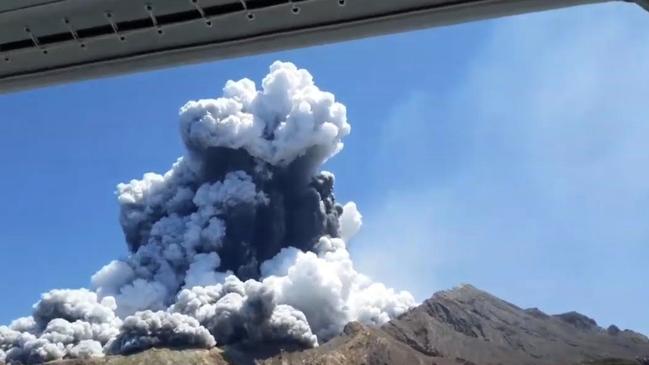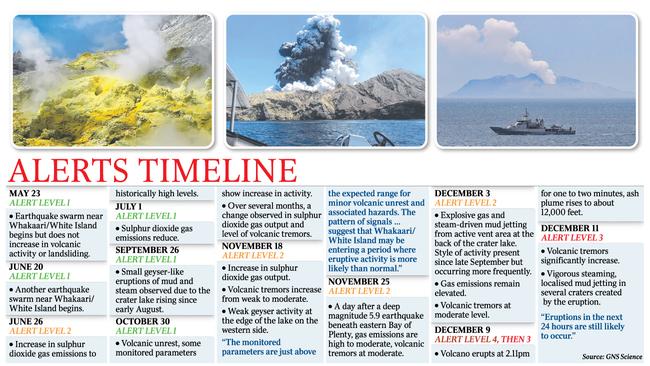NZ volcano tragedy: new video of White Island eruption shows ash cloud rushing toward tour boat
Footage shows the speed with which lethal ash engulfed White Island and threatened a boatload of tourists | WATCH
New and shocking footage of the White Island eruption has emerged, which shows the speed with which the lethal ash cloud engulfed the island and threatened a tour boat.
The video, filmed by Brazilian tourist Allessandro Kauffman and posted on YouTube, begins innocently enough with tourists arriving at the island and walking to the volcano crater. However, shortly after the tourists return to their boat, the volcano explodes, sending a huge cloud of ash into the air. Within seconds the enormous cloud of ash collapses, consuming the landscape and appearing to rush toward the boat.
As crew members shout at their clients to “go inside,” one tourist says: “This is terrifying,” advising a friend: “You can’t tell your mum this happened.” A frightened woman asks: “Are we going to make it?” while another points out: “There’s people there.”


Boatloads at volcano after alert raised
Boatloads of tourists were taken to White Island in the three weeks after New Zealand’s monitoring service raised the alert to level 2 and the agency described “explosive gas and steam-driven mud” jetting from the back of the crater lake.
The extent of the building volcanic activity on the island was noted by British geologist James Siddorn, who captured footage of the crater violently spewing rocks and mud when he visited just four days before the explosion.
READ MORE: Eighth White Island victim dies in hospital | ‘I feel nerves inside me’: dead tour guide’s volcano warning | Grieving father tells of last days with son | Tour operators decided when visits were safe | Sad journey home for surviving cruise guests | Boatloads at White Island after alert raised | 120 square metres of skin for grafts | Cricket’s tribute to volcano victims
The Australian has obtained the records of volcanic alert bulletins for Whakaari White Island since its last eruption in 2016.
They show that from mid-2019, authorities were concerned with earthquake swarms, geyser explosions and increased levels of sulphur dioxide.
“Our heightened monitoring of Whakaari as part of the response to recent earthquake swarms has shown an increase in sulphur dioxide gas flux to historically high levels,” says the GNS observation, made on June 26, when the alert level was raised to level 2, one level below an active eruption.
The agency reduced the alert level back to level 1 in July, but noted in September that “small, muddy, geyser-like explosions are occurring in the active crater at Whakaari/White Island due to a rising crater lake drowning the active vents. This geysering poses no risk to visitors.”
On November 18, it raised the alert level back to 2 because “over the last several weeks, we have observed an increase in the amount of SO2 gas output”. A week later, the agency observed that “moderate volcanic unrest continues”.
On December 3, six days before the tragedy that has so far claimed 14 lives, the agency said: “Explosive gas and steam-driven mud jetting continues from the active vent area at the back of the crater lake on Whakaari/White Island.”

Many of those who died were filmed walking through the crater lake at the time of the eruption.
The eruption has scientists questioning the ability to monitor the volcano and accurately predict eruptions.
Volcanologist Shane Cronin said scientists could not actually measure the activity of volcanoes such as White Island and trying to measure it more accurately might destabilise the volcano.
Professor Cronin, from the University of Auckland’s school of environment, said the best way to measure a volcano such as White Island would be to drill holes at various depths to measure changes in pressure, but he said the bores themselves could change the pressure.
White Island is visited by more than 20,000 people annually.
Monash University emeritus professor Ray Cas said the volcano was unpredictable and tourists should not have been allowed in the crater.
“I think it’s just fortunate that it hasn’t happened previously,” he said. “The fact it has finally happened should make everyone aware that this is not the last time it’s going to happen.”
He said the location of White Island also meant it would take a long time for an emergency response to arrive with the only evacuation by dinghy. “Just allowing people to get so close to the action is not a good idea,” he said.
Professor Cas said it would be better if tourist boats came close to the island for people to take photos but didn’t go ashore.
“To me, it’s a no-brainer,” he said. He said the intensity levels of the readings before Monday were probably not high enough to indicate there would be an imminent significant explosion.
Professor Cas said the location of the island volcano also would interfere with readings as sea water would enter through vents to where there would be molten rock and magma and become superheated and circulate at several hundred degrees or more.
“That’s what makes White Island so dangerous — even when the alert level is low, there can be this unpredictability,” he said.
Monitoring service GeoNet uses three parameters to assess risk — seismic activity, gas levels and land deformation.
Professor Cronin said one of the questions now being asked would be what further things could be done to measure safety risks. “What we’re trying to do is ensure the best information possible (is in) forecasts,” he said.
Professor Cronin said the sort of changes in the volcano that led to the eruption on Monday probably happened once a year without leading to an eruption.
“Only in hindsight can we see this signal A led to outcome B,” he said.



To join the conversation, please log in. Don't have an account? Register
Join the conversation, you are commenting as Logout